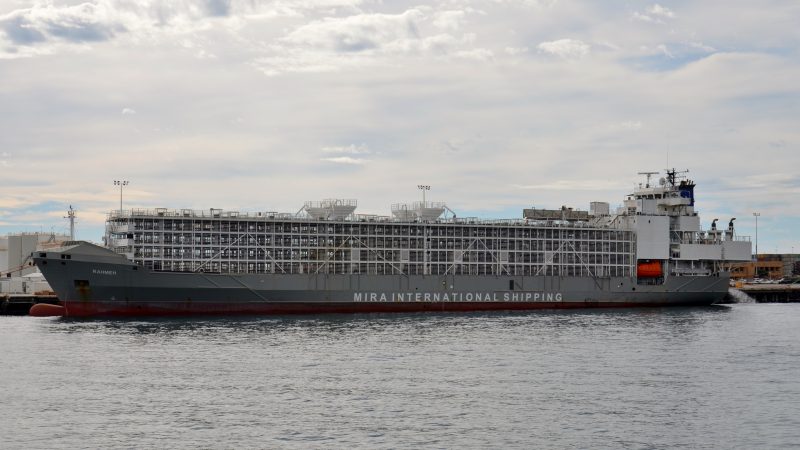Why was the Gulf Livestock 1 heading straight for the heart of category 4 storm Maysak, the worst typhoon of the year to date in the East China Sea? That is what maritime experts are wondering after having studied satellite images of the region by, among others, the Israeli maritime analysis bureau Windward.
The images show that all the other ships in the vicinity were moving away away from the heavy typhoon, which reached wind speeds of over 300 kilometres per hour. At the spot where the Gulf Livestock 1 disappeared, the wind reached speeds of 200 kilometres per hour and in all probability there were waves of more than 15 metres high.
It is unclear whether the ship’s communication equipment was working properly. If that is the case, it is virtually impossible for a captain to miss gale warnings. It is standard practice to change course in the event of a serious storm warning and to avoid the storm as much as possible. It has become known that the Filipino captain called his girlfriend in panic the night before the disappearance, saying that he was praying that the typhoon would abate.
One of the greatest maritime disasters in recent years
According to one of the rescued Philippines, Sareno Edvarodo, the ship’s propulsion had failed and it capsized after being hit by a huge wave. The crew had already been ordered to put on life jackets. Edvarodo said that he jumped into the water and did not see any other people on board before he was rescued. The second surviving crew member was not found on a floating life raft until two days later.
The question is to what extent the flag state of Panama is prepared to carry out an in-depth investigation into the circumstances of the shipwreck. The course of events surrounding the shipwreck of the also Panamanian Wakashio gives little cause for reassurance in this respect. Following the grounding, the Panamanian register issued a statement stating that the crew had manoeuvred to divert course, while analysis of satellite images showed that the bulk carrier had sailed in a straight line to the south-western tip of the island.
The livestock vessel had 43 people on board, two of whom, both from the Philippines, were rescued from the sea. It is feared that the other 41 and the 5800 cattle on board, were killed. A third person was found dead. The eighteen-year-old ship sent out a distress call last Tuesday night when it sailed an estimated 180 kilometres west of the Japanese island of Amami Oshima in the East China Sea. After that, nothing more was heard from it.
The Japanese coastguard resumed the search for the ship and the people on board this week after it was impossible to do so for some time due to the weather conditions. Given Edvarodo’s statement, it seems clear that the ship sank, and the chances of finding any more survivors are extremely slim. This would make it one of the greatest maritime disasters in recent years.
Container ship
The 134-metre Gulf Livestock 1 was launched in 2002 as a 630 TEU container ship in Germany and for many years commuted between Rotterdam and a series of Irish ports under the names Maersk Waterford and Dana Hollandia. The shortsea vessel was sold by the original owner Jungerhans in 2015 and converted into a lifestock carrier in Turkey. It was then renamed Rahmeh and in April last year renamed again to Gulf Livestock 1. As a result of the accident, questions will undoubtedly be asked about the suitability of a former converted short sea vessel on a deep sea route, where hurricanes are not an uncommon phenomenon.
The ship was on its way from Napier in New Zealand to Tangshan in China with a cargo of 5800 cows. The New Zealand animal rights organisation Safe, which has been fighting for years for a total ban on the export of live cattle, is ready to pounce on this. The organisation has published photographs of the “appalling conditions” under which the animals are transported according to Safe. Those photos were taken last year on board the Gulf Livestock 1 and show severely contaminated cows in a thick layer of dung. According to Safe, there is nothing to suggest that conditions have improved since then.
Agriculture Minister Damien O’Connor said earlier this year, following the publication of a research report on the sector, that ‘a conditional ban on the export of live cattle is one of the options under consideration’. According to the study, following the deaths of thousands of animals during transport, the value of live cattle exports last year was 54 million New Zealand dollars, just over EUR 30 million.
Amman
The vessel was operated by the Amman-based Hijazi & Ghosheh Group. Through its subsidiary Livestock Shipping Services, among others, it is engaged on a large scale in the maritime transport of cattle and sheep according to Islamic standards. It has a large subsidiary in Australia and has 11 livestock carriers, the largest of which can accommodate as many as 110,000 sheep.
The subsidiary Turkey Angosta Livestock imports more than 100,000 cattle annually from Australia, the United States, Brazil, Argentina, New Zealand and other countries in the Gulf region and North Africa. On its site, the group says that under the name Angos Livestock it owns huge farms in Australia, Mexico and Uruguay, plus smaller ones in 25 other countries, with enough space for more than 2 million animals. Under the curious slogan “The number of the world”, Angos boasts ‘unlimited import and export of live animals all over the world’.
This article first appeared in Dutch on Nieuwsblad Transport, a publication of SWZ|Maritime’s publishing partner Promedia.
Picture: Gulf Livestock 1 in 2016, then named Rahmeh (by Bahnfrend).








